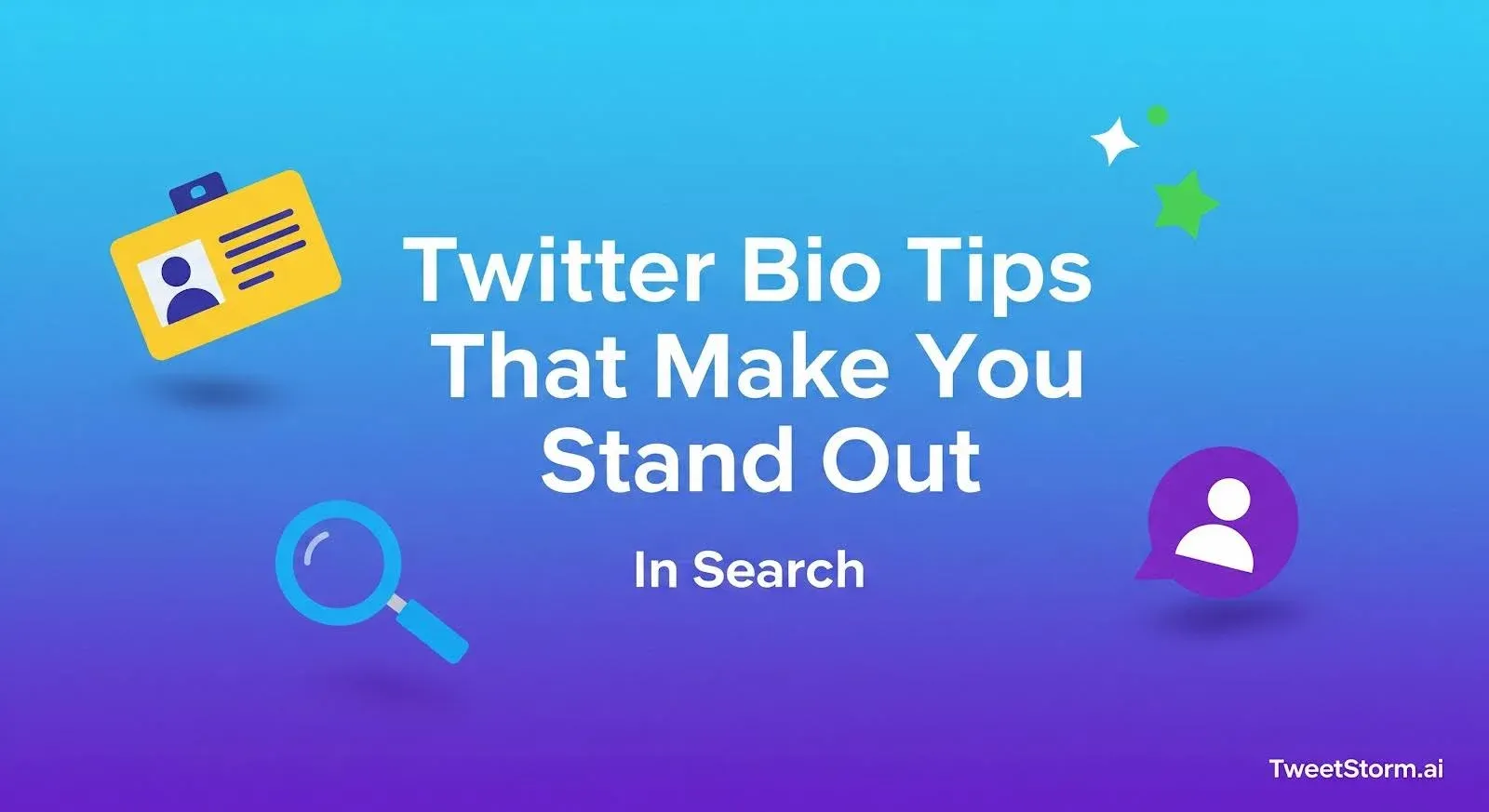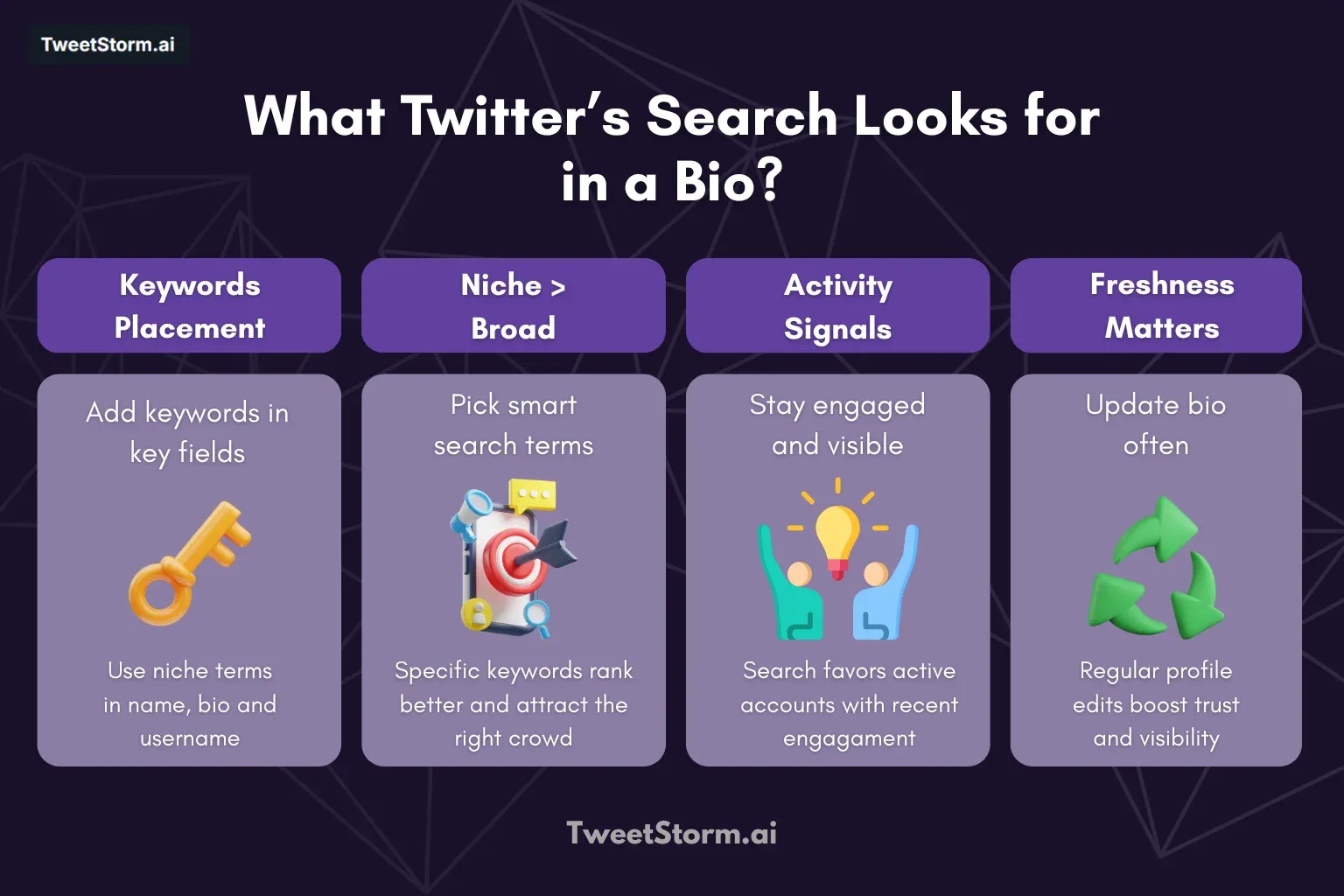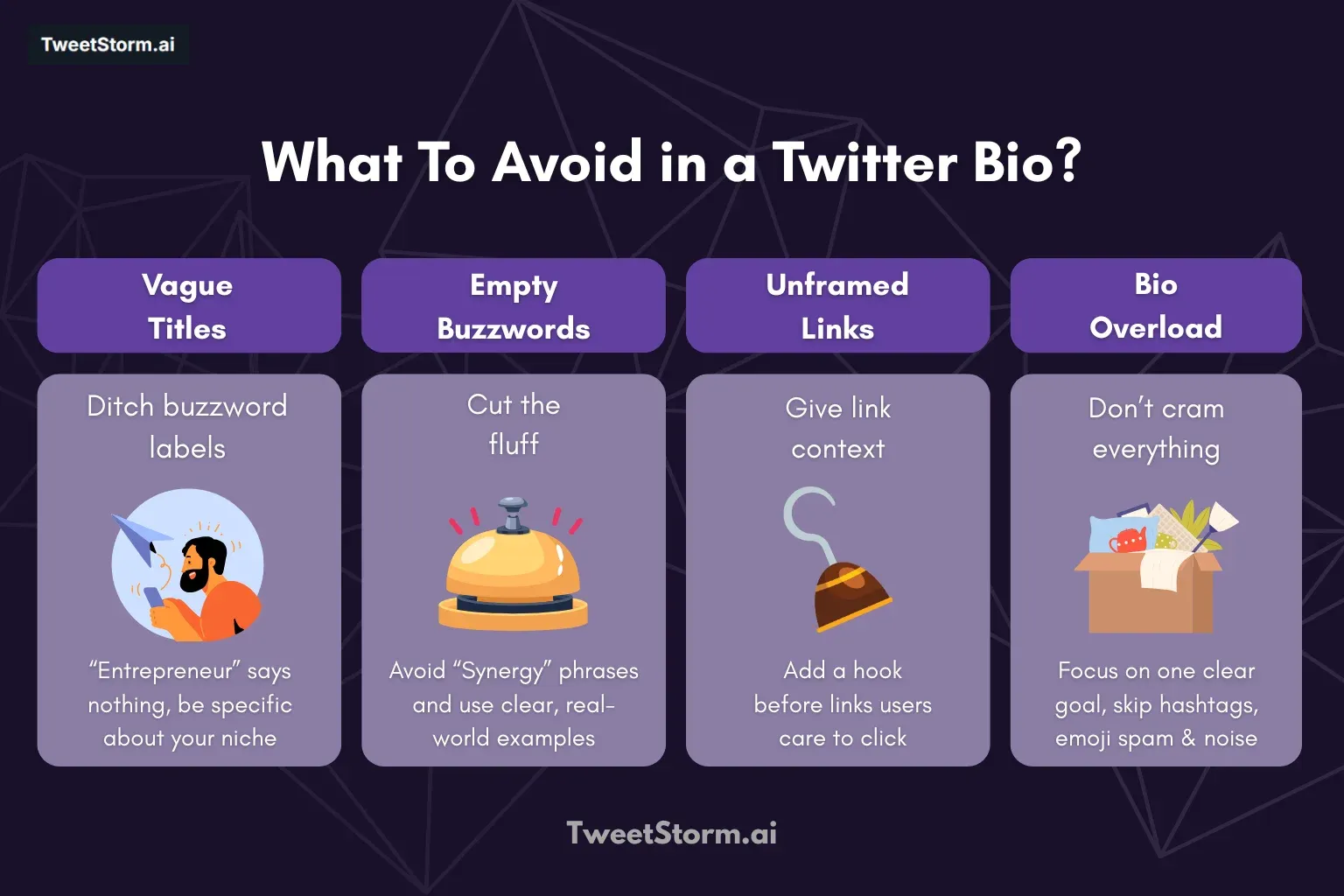Twitter bio tips that make you stand out in search
Ejaz Ahmed
28 Jul 2025 | 6 min read


Your Twitter bio is vital. It's your first impression, a powerful tool for discoverability. You have seconds to grab attention, show relevance, and answer: "Who are you and why care?" A strong Twitter bio does this instantly.
Your Twitter bio (name, handle, bio field) is key for visibility. Optimizing it with keywords boosts search engine (Google, Twitter) ranking, signaling your profile's relevance.
A strong Twitter bio boosts visibility, attracts followers, drives clicks, and builds credibility, proving you're worth engaging with. Ignoring it means lost opportunities.
What Twitter's search looks for in a bio?

Your Twitter bio is vital for both humans and Twitter's algorithm, acting as a key signal for search. Understanding how search works helps you craft a bio that gets found. Here’s what Twitter’s search prioritizes:
1. Keyword relevance (your golden ticket)
Twitter search heavily weights keywords in three specific fields:
- Your name field: Highest priority. Include your core identifier and key expertise (e.g., "Jane Doe | AI Ethics Researcher").
- Your handle (@username): while less flexible, incorporating a relevant keyword (if available) helps (e.g., @sustainablemarketer).
- Your Twitter bio text: This is your main keyword real estate. Integrate terms your target audience actually searches for (e.g., "SaaS growth marketing," "Python instructor," "sustainable fashion advocate"). Placement matters: Keywords near the start carry more weight.
Niche vs. Broad keywords:
Niche keywords | Broad keywords |
Less competition, higher intent | High competition, vague intent |
Targets specific audience | Harder to rank for |
Better for most profiles! | Use sparingly alongside specifics |
2. Activity-based ranking (the engagement factor)
Keywords alone won’t cut it. Twitter’s algorithm rewards active, engaging profiles in search results. Key factors:
- Recent engagement: Regular replies, retweets (especially quote retweets) and mentions signal an active, valuable account.
- Follower count & quality: While not the sole factor, a credible follower base (especially in your niche) boosts authority signals.
- Tweet freshness: Consistently posting relevant content tells the algorithm your profile is current and topical.
3. Profile completeness & freshness
A sparse or outdated profile is a red flag for both users and algorithms:
- Completeness: Fill all fields: profile pic, header image, location (if relevant), website link and birthday (for personal brands). Missing elements reduce trust signals.
- Freshness: Updating your bio periodically (e.g., adding a new achievement, changing a link) signals activity. A bio unchanged for 5 years looks abandoned, even if you tweet daily.
The 4 core elements of a high-impact Twitter bio

Your Twitter bio is a precision instrument, not a dumping ground. To maximize visibility and conversion, every character must serve a purpose.
These four non-negotiable elements transform a forgetgettable snippet into a powerful profile magnet:
1. Niche clarity: answer "who do you serve?" instantly
Vagueness is the enemy of connection. Within seconds, your Twitter bio must telegraph your specific domain and audience. Ditch generic titles ("Entrepreneur," "Thought Leader") for concrete descriptors.
- Weak: "Marketing expert helping businesses grow."
- Strong: "Email conversion geek for bootstrapped SaaS founders | Turning sign-ups into paying customers."
- Why it works: Immediately tells WHO (bootstrapped SaaS founders) and WHAT (improving email conversion → paying customers). This attracts your ideal audience and repels irrelevant clicks.
2. Strong keywords: fuel the search engines (human & algorithmic)
Integrate the terms people actually search for related to your niche. This isn't stuffing; it's strategic relevance.
- Placement power: Prioritize keywords in your Name field (e.g., "Alex Chen | Shopify SEO Consultant"). Use the Twitter bio text for secondary keywords and semantic variations (e.g., "e-commerce search visibility," "product page optimization").
- Think like your audience: What would someone needing your help type into Twitter or Google? (e.g., "freelance Figma designer," "startup HR advice," "Python data analysis tutorials").
- Crucial balance: Keywords must flow naturally within your niche clarity statement. Forced lists hurt readability and credibility.
3. Tone alignment: match your content & audience
Your Twitter bio sets expectations for your voice. Mismatched tone confuses followers and hurts engagement. Choose deliberately:
- Expert/Professional: "Award-winning science journalist covering climate policy | Nature, NYT contributor." (Formal, credential-focused)
- Bold/Provocative: "Debunking bad nutrition science." (Direct, opinionated)
- Funny/Casual: "Purveyor of terrible puns & decent marketing tips. Probably over-caffeinated." (Relatable, humorous)
- Creative/Intriguing: "Building worlds one pixel at a time. Indie game dev dreaming in code." (Evocative, niche-specific)
Consistency is key: If your tweets are witty, your Twitter bio shouldn't read like a corporate memo.
4. Social proof: the credibility accelerator (use sparingly!)
A touch of validation cuts through skepticism. Choose one killer element, not your entire resume:
- Mentions: "Featured in: Forbes, TechCrunch"
- Achievements: "Built $1M+ Shopify brand → Teaching others" or "Ex-Google PM"
- Media: "Host of 'The Future of Work' Podcast"
- Relevant links: "Building @YourProductName" or "Writing at yourblog.com"
- Audience proof: "Community for 10k+ UX designers" (if verifiable)
Avoid: Generic "Award-winning" (which award?) or long lists. One potent credential > three weak ones.
The synergy: These elements interlock. Your niche clarity defines the keywords. Your keywords attract the right audience for your tone. Your tone delivered with social proof builds instant trust. Omit one and the Twitter bio loses potency.
What to avoid in a Twitter bio?

A compelling Twitter bio requires impactful content and concise editing. Avoid these common pitfalls that sabotage search visibility and credibility:
1. Vague job title labels
Don't use unclear words like "Entrepreneur" or "Guru" in your Twitter bio. Instead, use specific words that show what you do and what you specialize in.
2. Repetitive buzzword stuffing
Don't use fancy words like "passionate innovative disruptor." Instead, clearly state what you've done, like "Acquisition lead @FintechApp | Grew free trials 220% in 6 months."
3. Naked links (without context)
Instead of just a link, explain why people should click it. For example, "🎙 Daily podcast: Breaking down crypto regulation → podcast.site."
4. Twitter bios that say nothing
Make your Twitter bio specific, not general. Use relevant keywords for skills/interests.
5. Twitter bios that say everything
Keep your Twitter bio focused on one main goal.
How TweetStormAI helps you create a better Twitter bio?

Most people write their Twitter bio once and never revisit it. But if your profile is your homepage, your Twitter bio is your headline. It decides whether someone follows, clicks or skips.
TweetStormAI, gives creators a way to stop guessing what works and start generating Twitter bios that actually do work.
1. Tailored bios with real-time tone control
TweetStorm's AI Twitter Bio Generator creates optimized bios fast. Match your bio's tone (professional, funny, geeky) to your brand and strategy.
2. Built-In keyword intelligence
TweetStorm boosts your Twitter and Google visibility through keyword-optimized Twitter bios (indexing, GPT, AI tools, web3, product names).
3. Easy testing and swapping
TweetStorm's "My Generations" feature is pretty cool because it lets you save all your bio drafts. Easily switch between serious and playful versions to find what works best without rewriting.
4. Include emojis toggle
Optional toggle, that lets users enrich the visual tone of Twitter bios.
TweetStorm isn’t just helping you tweet, it’s giving you full-stack tools to refine the entire impression you leave on Twitter.
Final thoughts
Your Twitter bio, though small, is crucial. It quickly communicates what you do, your interests, and why you're worth following. A strategic Twitter bio helps you stand out.
Your X (Twitter) bio is key for brand building. Refine your voice, tone, and format with tools like TweetStormAI. Use keywords for discoverability and a strong first impression.
TweetStormAI's bio generator offers flexible, brand-aware, and performance-driven bios, outperforming static builders. Ideal for teams or creators, it's a significant time-saver.
Because before someone reads your tweets, they read your Twitter bio. Make it count.
FAQs
1. Why does my Twitter bio matter so much?
Your Twitter bio is one of the first things users (and search engines) see. It helps define your niche, communicate value and increase discoverability through keywords. A strong bio builds instant trust and clarity.
2. What keywords should I add to my Twitter bio?
Think about terms people might search to find someone like you, for example: “SaaS founder,” “web3 designer,” or “newsletter tips.” Use specific, niche-relevant language, not vague buzzwords.
3. Can hashtags improve my Twitter bio visibility?
Hashtags don’t affect Twitter bio SEO, but they can signal what communities you belong to. Use them sparingly, 1 or 2 max, only if they’re directly tied to your identity or work.
4. How often should I update my Twitter bio?
Review your bio at least quarterly or whenever your goals, positioning or projects shift. A stale or misaligned bio can confuse followers or miss search opportunities.
5. Can TweetStormAI help me write a better Twitter bio?
Yes. TweetStormAI includes a built-in Bio Generator that lets you experiment with tone, structure and niche keywords. It’s great for brainstorming sharper intros, especially when testing personal vs. professional vibes.